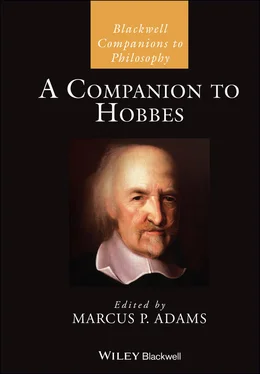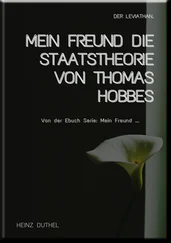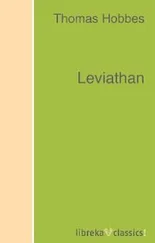This chapter has contrasted Hobbes’s statements about natural philosophy, and the structure of his philosophy, generally, with two cases from his practice of explaining in optics and natural philosophy. These cases show that rather than providing deductions from first philosophy or geometry, within particular explanations Hobbes blended everyday experience (the “that”) with appeals to causal principles from geometry (the “why”). In doing so, Hobbes treats physical bodies as if they are mathematical objects. Furthermore, Hobbes provides no bridge principles that would expose a reduction of these phenomena to minute particles. This “mixing” of two areas (geometry with everyday experience), places natural philosophy in the middle of his bifurcation of knowledge into scientia and cognitio . On the one hand, humans lack certain knowledge since they are not the creators of natural phenomena, but on the other hand natural philosophy strives to be more than mere prudence and, when mixed with causal principles from geometry, can offer suppositional certainty.
1 1 My goal is not to establish the reception or broad influence of Hobbes’s optics. Shapiro (1973) has done so by tracing the influence of Hobbes’s account of refraction and theory of light upon Emmanuel Maignon, Isaac Barrow, and Robert Hooke, among others. See also Malet (2001, 315–17) for discussion of Hobbes’s criticisms of the optics of Claude Mydorge and Walter Warner. On accusations by Seth Ward that Hobbes plagiarized others’ work in his optics, see Prins (1993).
2 2 See Adams (2019) for discussion of this example of “square” and connection to Hobbes’s assertion that humans “make the principles” of civil philosophy. Helen Hattab (this volume, Chapter 1) connects this example to Hobbes’s universal method.
3 3 Adams (2019, 12–13) connects these two routes to Hobbes’s discussion of the individual, “not trusting this Inference, made from the Passions,” who might want to have it “confirmed by Experience” (Hobbes 2012, 194; 1651, 62).
4 4 For discussion of how Hobbes’s view of causality relates to Aristotle’s and to Scholastic Aristotelians, see Leijenhorst (1996).
5 5 Hobbes requires that geometrical definitions be generative, and he rejects Euclidean definitions because they are not (EW VII.184).
6 6 I have modified Gert’s (1994b [1658]) translation to reflect the wording in OL.
7 7 See also Posterior Analytics I.9 (76a4-13; Aristotle 1984, 123) and Metaphysics M.3 1078a14-16 For discussion of Aristotle’s view of subalternate sciences and Galileo, see Lennox (1986).
8 8 Indeed, in Minute Hobbes describes vision “in general” as “that fancie which is caused in any living creature” (1983 [1646], 334). Médina (2016, 42) suggests that the placement of optics within De homine, rather than in De corpore, relates to Hobbes’s division in Minute between illumination (Part I) and vision (Part II) and suggests that this division is similarly reflected in Hobbes’s separation of sciography from optiques in the Table in Leviathan 9 (2012, 131). The former studies consequences “from the Qualities of the Starres” and the latter consequences from the “Qualities of Bodies Terrestriall.” However, were this strict division Hobbes’s intention behind placing optics within De homine (and not within De corpore), it would not explain why De corpore Part IV (chapter XXV) opens with the discussion of “sense”.
9 9 du Verdus to Hobbes (August 17/27, 1656; Hobbes 1994a, 298, 299); Sorbière to Hobbes (December 13/23, 1656; Hobbes 1994a, 388, 391); du Verdus to Hobbes (May 17/27, 1657; Hobbes 1994a, 468, 471); Fermat to Hobbes (June 5/15, 1657; Hobbes 1994a, 474, 475); de Martel to Hobbes (July29/ August 8, 1657; Hobbes 1994a, 480, 482); and de Martel to Hobbes (August 7/17, 1657; Hobbes 1994a, 483, 484).
10 10 Although geometry plays this role in the account of the optic axis and the visual line in De homine, and elsewhere in Hobbes’s optics, geometry does not serve as the “why” in all explanations, such as in Minute where Hobbes’s account of the nature of light plays an explanatory role in understanding the production of heat (see Malet 2001, 320).
11 11 I develop this explanation in more detail in Adams (2016, 47–8). I discuss Hobbes’s borrowing (and citing) of geometrical principles in his criticisms of Robert Boyle in Dialogus Physicus in Adams (2017).
1 Adams, Marcus P.2016. “Hobbes on Natural Philosophy as ‘True Physics’ and Mixed Mathematics.” Studies in History and Philosophy of Science 56: 43–51.
2 Adams, Marcus P.2017. “Natural Philosophy, Deduction, and Geometry in the Hobbes-Boyle Debate.” Hobbes Studies 30: 83–107.
3 Adams, Marcus P.2019. “Hobbes’s Laws of Nature in Leviathan as a Synthetic Demonstration: Thought Experiments and Knowing the Causes.” Philosophers’ Imprint 19 (5): 1–23.
4 Aristotle. 1984. The Complete Works of Aristotle, Vol. I, edited by Jonathan Barnes. Princeton, NJ: Princeton University Press.
5 Biener, Zvi. 2016. “Hobbes on the Order of Sciences: A Partial Defense of the Mathematization Thesis.” The Southern Journal of Philosophy 54 (3): 312–32.
6 Hampton, Jean. 1986. Hobbes and the Social Contract Tradition. Cambridge: Cambridge University Press.
7 Hobbes, Thomas. 1839–1845a. The English Works of Thomas Hobbes, 11 vols., edited by Sir William Molesworth. London: John Bohn. Cited as EW.
8 Hobbes, Thomas. 1839–1845b. Thomæ Hobbes malmesburiensis opera philosophica, 5 vols., edited by Gulielmi Molesworth. London: John Bohn. Cited as OL.
9 Hobbes, Thomas. 1973 [1642–1643]. Critique du De Mundo de Thomas White, edited by Jean Jacquotand Harold Whitmore Jones. Paris: Vrin.
10 Hobbes, Thomas. 1976 [1642–1643]. Thomas White’s De Mundo Examined, translated by Harold Whitmore Jones. London: Bradford University Press.
11 Hobbes, Thomas. 1981. Computatio sive Logica: Logic. Translation and Commentary by Aloysius P. Martinich, edited by Isabel C. Hungerlandand George R. Vick. New York: Abaris Books.
12 Hobbes, Thomas . 1983 [1646]. Thomas Hobbes’s a Minute or First Draught of the Optiques: A Critical Edition, edited by Elaine C. Stroud. PhD Dissertation. Madison, WI: University of Wisconsin-Madison.
13 Hobbes, Thomas. 1994a. The Correspondence of Thomas Hobbes, 2 vols., edited by Noel Malcolm. Oxford: Clarendon Press.
14 Hobbes, Thomas. 1994b [1658]. Man and Citizen: De homine and De cive, edited and translated by Bernard Gert. Indianapolis, IN: Hackett.
15 Hobbes, Thomas. 2012 [1651]. Leviathan, 3 vols., edited by Noel Malcolm. Oxford: Clarendon Press.
16 Leijenhorst, Cees. 1996. “Hobbes’s Theory of Causality and Its Aristotelian Background.” The Monist 79 (3): 426–47.
17 Lennox, James. 1986. “Aristotle, Galileo, and the ‘Mixed Sciences’.” In Reinterpreting Galileo, edited by William A. Wallace, 29–51.Washington, DC: Catholic University Press.
18 Malcolm, Noel. 2002. Aspects of Hobbes. Oxford: Clarendon Press.
19 Malet, Antoni. 2001. “The Power of Images: Mathematics and Metaphysics in Hobbes’s Optics.” Studies in History and Philosophy of Science 32 (2): 303–33.
20 Martinich, Aloysius P.2005. Hobbes. New York, London: Routledge.
21 Médina, José. 2016. “Hobbes’s Geometrical Optics.” Hobbes Studies 27 (1): 39–65.
22 Peters, Richard. 1967. Hobbes. Baltimore, MD: Penguin Books.
23 Prins, Jan. 1993. “Ward’s Polemic with Hobbes on the Sources of His Optical Theories.” Revue d’histoire des sciences 46: 195–224.
24 Ryan, Alan. 1970. The Philosophy of the Social Sciences. London: Macmillan.
Читать дальше












